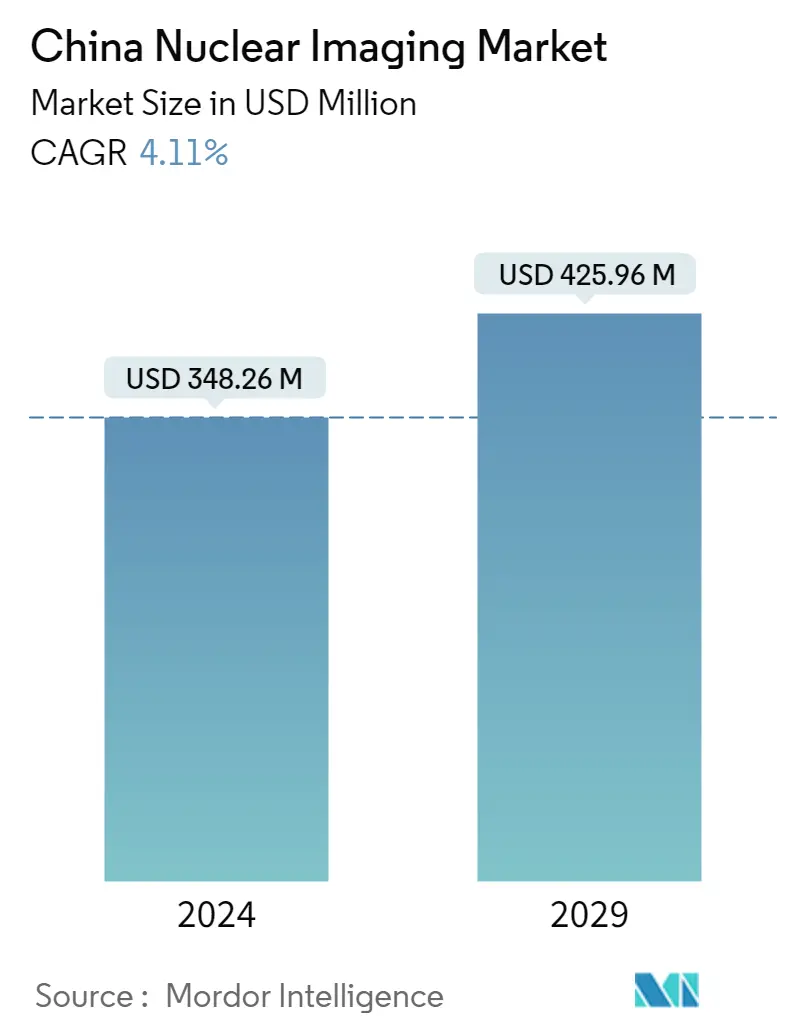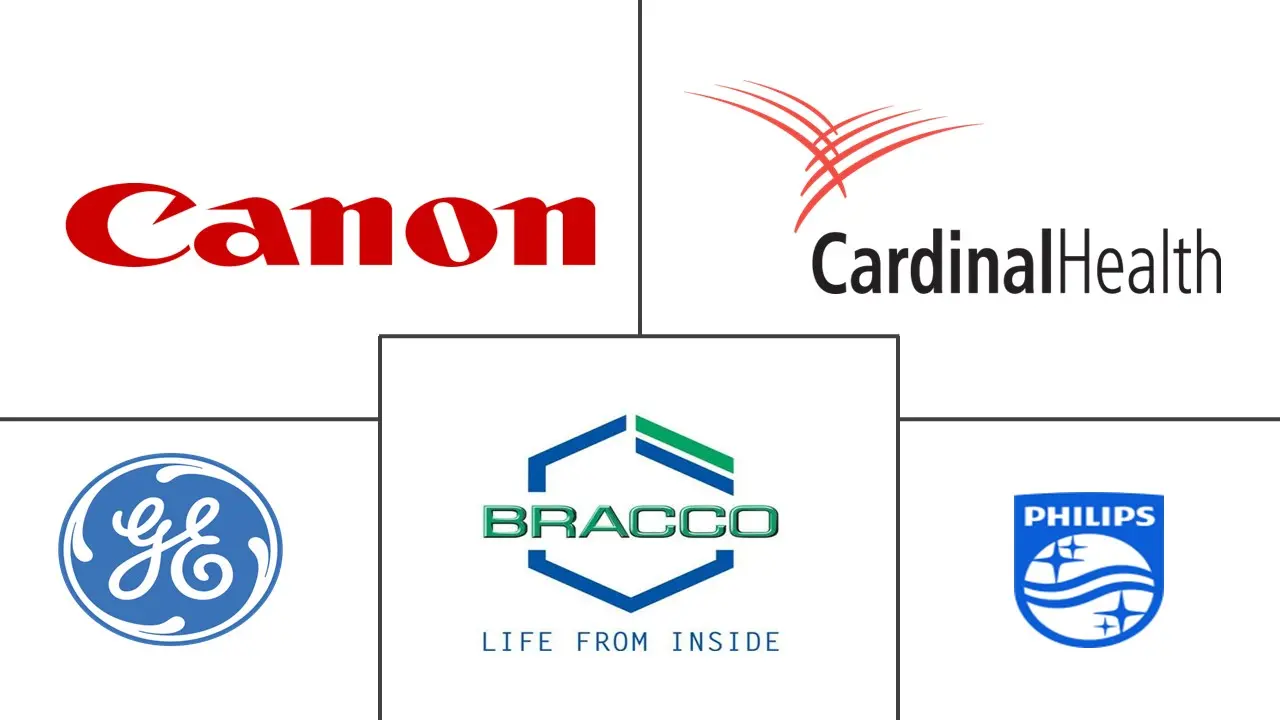Market Size of China Nuclear Imaging Industry

| Study Period | 2021 - 2029 |
| Base Year For Estimation | 2023 |
| Forecast Data Period | 2024 - 2029 |
| Market Size (2024) | USD 348.26 Million |
| Market Size (2029) | USD 425.96 Million |
| CAGR (2024 - 2029) | 4.11 % |
Major Players
*Disclaimer: Major Players sorted in no particular order |
China Nuclear Imaging Market Analysis
The China Nuclear Imaging Market size is estimated at USD 348.26 million in 2024, and is expected to reach USD 425.96 million by 2029, growing at a CAGR of 4.11% during the forecast period (2024-2029).
During the early phase of the pandemic, the Chinese government froze nationwide public transportation, which, in turn, halted all imaging and therapy in the nuclear medicine departments, and radioimmunoassay procedures were postponed till the situation returned to normal. The supply of radioisotopes is showing a recovery phase by managing the adverse impact of COVID-19 in China. For instance, in April 2022, the China Isotope & Radiation Corporation (CIRC), a company that is involved in radioactive sources and irradiation, and nuclear medicine, stated that, while resolving the issues brought on by the COVID-19 pandemic, the company transitioned into the 14th five-year plan. The yearly report showed steady growth and strong financial achievement for 2021. Thus the companies are recovering from the adverse impact of COVID-19 and are expected to do the same over the forecast period.
The major factors driving the growth of the Chinese nuclear imaging market include the rising burden of chronic diseases, increasing technological advancements, and growth in nuclear medicine and imaging applications. One of the major chronic diseases in China includes dementia which can be diagnosed using nuclear imaging techniques. Hence with the increasing burden of dementia in the region, it is expected to have significant growth in the market. For instance, as per the study published by the Journal of Psychogeriatrics in November 2022, the prevalence of dementia was high among elder adults residing in Xiamen, China. Thus, the demand for nuclear imaging increases with the high prevalence of dementia and is expected to boost the growth of the market over the forecast period.
Furthermore, with new centers for radioisotope research in the region, it is expected to have new applications and boost the market's growth. For instance, in February 2022, INVAP, an Argentine company, stated that the nuclear medicine research and radioisotope production facility would be constructed in China due to the interest in Argentine technology for nuclear medicine. Hence, China formulated a national plan to produce Molybdenum-99 and other radioisotopes for medical use. Thus, with the new nuclear medicine research facility in China, the demand for radioisotopes is expected to increase, which would help the market to grow over the forecast period.
However, the shorter half-life of radiopharmaceuticals and the high cost of the techniques are anticipated to hamper the growth of the market over the forecast period.
China Nuclear Imaging Industry Segmentation
Nuclear medicine imaging procedures are non-invasive and, with the exception of intravenous injections, are usually painless medical tests that help physicians diagnose and evaluate medical conditions. Nuclear imaging scans use radioactive materials called radiopharmaceuticals or radiotracers. The Chinese nuclear imaging market is segmented by product (equipment, radioisotope, and PET radioisotopes) and application (SPECT application and PET application). The report offers values in USD million for all the above-mentioned segments.
| By Product | ||||||||||||||
| Equipment | ||||||||||||||
|
| By Application | ||||||
| ||||||
|
China Nuclear Imaging Market Size Summary
The China Nuclear Imaging Market is poised for significant growth over the forecast period, driven by the increasing prevalence of chronic diseases, technological advancements, and the expansion of nuclear medicine applications. The market is recovering from the disruptions caused by the COVID-19 pandemic, with companies like the China Isotope & Radiation Corporation adapting to new strategic plans to mitigate past impacts. The rising incidence of conditions such as dementia and Parkinson's disease is expected to boost the demand for nuclear imaging techniques, including SPECT and PET, which are crucial for diagnosis and research in neurology and oncology. The establishment of new radioisotope research centers and facilities, such as those initiated by INVAP and other international collaborations, is anticipated to further enhance the market's growth by increasing the availability and application of radioisotopes in medical settings.
Technological innovations and strategic partnerships among key market players are also contributing to the market's expansion. Companies like United Imaging and IBA are introducing advanced technologies and equipment that enhance imaging capabilities and improve patient outcomes. The integration of nuclear medicine with biochemical analysis in PET imaging is advancing cancer diagnosis and treatment, reflecting the growing interconnection between oncology and nuclear imaging. Major industry players, including Bayer AG, Siemens Healthcare, and GE HealthCare, are focusing on research and development to maintain their competitive edge and drive market growth. Despite challenges such as the high cost of techniques and the shorter half-life of radiopharmaceuticals, the market is expected to continue its upward trajectory, supported by ongoing technological advancements and increasing demand for diagnostic imaging solutions.
China Nuclear Imaging Market Size - Table of Contents
-
1. MARKET DYNAMICS
-
1.1 Market Overview
-
1.2 Market Drivers
-
1.2.1 Rising Burden of Chronic Diseases
-
1.2.2 Increasing Technological Advancements with Growth in Applications of Nuclear Imaging
-
-
1.3 Market Restraints
-
1.3.1 High Cost of the Techniques
-
1.3.2 Short Half-life of Radiopharmaceuticals
-
-
1.4 Porter's Five Force Analysis
-
1.4.1 Threat of New Entrants
-
1.4.2 Bargaining Power of Buyers/Consumers
-
1.4.3 Bargaining Power of Suppliers
-
1.4.4 Threat of Substitute Products
-
1.4.5 Intensity of Competitive Rivalry
-
-
-
2. MARKET SEGMENTATION (Market Size by Value - USD million)
-
2.1 By Product
-
2.1.1 Equipment
-
2.1.2 Radioisotope
-
2.1.2.1 SPECT Radioisotopes
-
2.1.2.1.1 Technetium-99m (TC-99m)
-
2.1.2.1.2 Thallium-201 (TI-201)
-
2.1.2.1.3 Gallium (Ga-67)
-
2.1.2.1.4 Iodine (I-123)
-
2.1.2.1.5 Other SPECT Radioisotopes
-
-
2.1.2.2 PET Radioisotopes
-
2.1.2.2.1 Fluorine-18 (F-18)
-
2.1.2.2.2 Rubidium-82 (RB-82)
-
2.1.2.2.3 Other PET Radioisotopes
-
-
-
-
2.2 By Application
-
2.2.1 SPECT Applications
-
2.2.1.1 Neurology
-
2.2.1.2 Cardiology
-
2.2.1.3 Thyroid
-
2.2.1.4 Other SPECT Applications
-
-
2.2.2 PET Applications
-
2.2.2.1 Oncology
-
2.2.2.2 Cardiology
-
2.2.2.3 Neurology
-
2.2.2.4 Other PET Applications
-
-
-
China Nuclear Imaging Market Size FAQs
How big is the China Nuclear Imaging Market?
The China Nuclear Imaging Market size is expected to reach USD 348.26 million in 2024 and grow at a CAGR of 4.11% to reach USD 425.96 million by 2029.
What is the current China Nuclear Imaging Market size?
In 2024, the China Nuclear Imaging Market size is expected to reach USD 348.26 million.

